London Eye at 20: The wheel that changed the capital's skyline
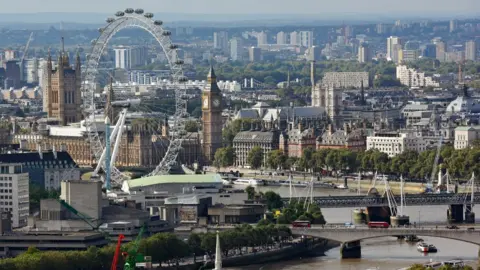 BBC
BBCOn the last day of 1999, thousands of revellers gathered on the banks of the River Thames in London to wait for the spectacular firework display heralding the new millennium.
But the end of a century was only the beginning for what is now an integral part of the capital's skyline - the Millennium Wheel. After wishing peace and prosperity upon the nation, the prime minister Tony Blair fired a laser beam across the Thames to mark the wheel's official opening.
The landmark now known as the London Eye performed a rotation, although without any passengers. A technical issue meant it was not until March 2000 the public could go aboard.
In the 20 years since that New Year's Eve night, the Eye has become an integral part of London's skyline, despite the fact the structure was only supposed to be in place temporarily.
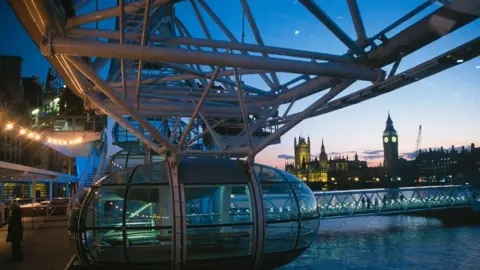 Marks Barfield/Nick Wood
Marks Barfield/Nick WoodStanding 135m (443ft) tall, the cantilevered observation wheel is a feat of both vision and engineering.
It was the brainchild of husband-and-wife team David Marks and Julia Barfield, of Marks Barfield Architects, who in 1993 entered their design into a competition held by the Architecture Foundation and The Times newspaper to find the best idea for a landmark to welcome in the new century.
Mr Marks, who died two years ago, liked the idea of a big wheel because he wanted something that people could participate in and enjoy while up high, according to Ms Barfield.
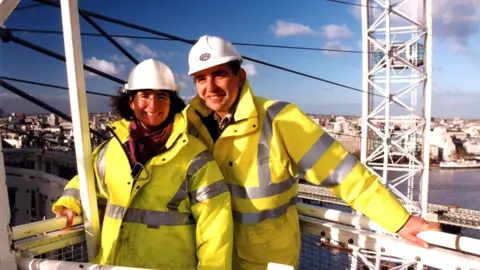 Marks Barfield Architects
Marks Barfield Architects"David felt the wheel has always been used as a symbol of time and symbolically it fitted," Ms Barfield said. "It's actually one where the journey is as important as the arrival - the view unfolds as you go round."
The judges were not impressed with their idea or indeed any of the entries, all of which were rejected. But having invested time and effort in the application, the couple decided they would forge ahead and set up the Millennium Wheel Company.
They lacked financial backing at this point - their industry was in recession - but both were convinced of the project's merits.
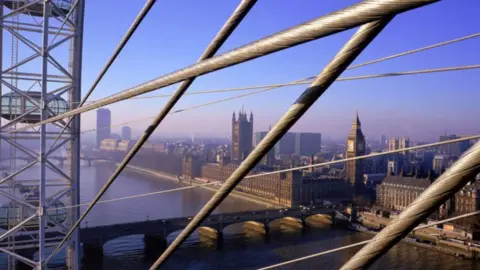 Marks Barfield Architects/Nick Wood
Marks Barfield Architects/Nick WoodMs Barfield decided the observation wheel should be positioned close to the River Thames, on the South Bank near County Hall.
But there was a major complication - they did not own the land. It belonged to the Arts Council (AC), which had leased it to the South Bank Centre (SBC).
After lengthy negotiations with both the AC and SBC, the architects were given consent to use the land and this led to Lambeth Borough Council granting initial planning permission.
However, this was just the first hurdle. A far bigger one was finding a way to raise the money for the multimillion-pound project.
According to Ms Barfield, they had a stroke of luck when a journalist at London's Evening Standard newspaper came across their planning application and brought it to the attention of the paper's editor.
The Standard decided to support them and launched a "Back the Wheel" campaign.
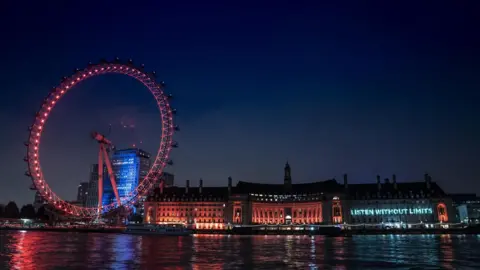
This kick-started discussions with various potential backers, including the chief executive of British Airways, Sir Bob Ayling. The airline decided to fund the venture in exchange for 50% of the Millennium Wheel Company.
The architects were now able to secure further funding and submit a full planning proposal.
Ms Barfield said she and her husband had conversations with at least 25 groups and societies representing London, as well as its 32 boroughs.
Marks Barfield was using computer-aided design, or CAD, which by the mid-90s was capable of generating images that were much more impressive than what had gone before. Ms Barfield said this really helped sell the project, and the plans were finally approved in 1996.
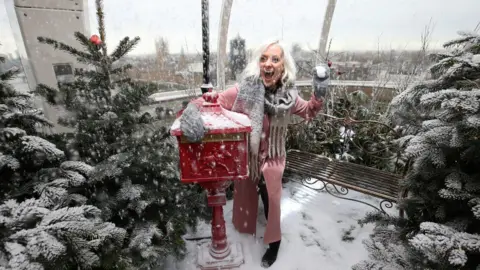 Press Association
Press AssociationHowever, according to Ms Barfield, the project was still in danger of foundering.
There were fears the secretary of state for the environment, John Gummer, might call for a review of the application, causing a delay the project could not afford.
"If he had, it wouldn't have happened. We didn't have funds for a delay," Ms Barfield said.
There was a vocal opponent in the shape of the chairman of the Royal Fine Art Commission and former Tory minister Lord St John of Fawsley, who said the wheel would be a "white elephant".
"We felt that he took against it instantly," said Ms Barfield, although the chairman of English Heritage, Jocelyn Stevens, was more supportive. He was quoted as saying "we should embrace and celebrate heritage of the future, as well as the past".

Well Eye say
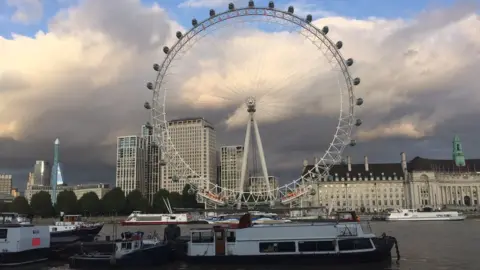 Mariam Issimdar
Mariam Issimdar- Hollywood star Jessica Alba claims the record number of rotations by an overseas celebrity, at 31
- There have been over 5,000 marriage proposals on the Eye
- All oils used on the Eye are biodegradable; the grease is edible and causes no harm to wildlife
- The capsules represent the 32 London boroughs but are numbered up to 33 as there is no capsule 13
- The Eye was granted permanent status in 2002
- More than 3.5 million people visited the Eye in 2018
Source: Coca-Cola London Eye

Building work on the Eye began in 1998. It was made in sections and transported along the Thames by barge before being assembled on site. About 1,700 tonnes of British steel were used in its construction.
To stay upright, the wheel depends on a massive central hub and spindle, which is 23m long and weighs 330 tonnes.
Originally the wheel was to have 60 pods, representing each minute of the clock, but after tests at a ski-resort it was decided there would be 32. As well as being more cost-effective, this number of capsules allowed better views for riders.
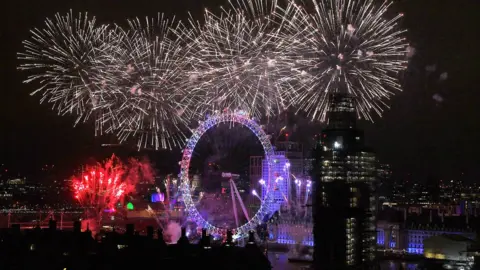
For Ms Barfield, a significant moment came early one morning when she watched from a bench on the opposite side of the river as the wheel was being moved from its horizontal position to the vertical.
It was then it dawned on her the beauty of their creation. "The sun was rising behind it and it was hovering over the river at a 35-degree angle - that was pretty special," she said.
The first passengers to test the wheel, in December 1999 - mostly people who had backed the project or been involved in building it - almost did not include the architects. They received a call at the last minute saying it was ready and could they get there quickly.
"For me the most wonderful culmination was the amazing pre-eminence of St Paul's Cathedral, a perspective that had not been seen before," said Ms Barfield.
Although Marks Barfield has been behind many feats of engineering since, including Brighton's i360 tower and Kew Gardens' treetop walkway, Ms Barfield remains extremely proud of the Eye.
"The observation wheel gives Londoners and visitors another way to appreciate the capital and being by the river really enhances this experience," she said.
"We couldn't have predicted its success and longevity. It's very heartening."
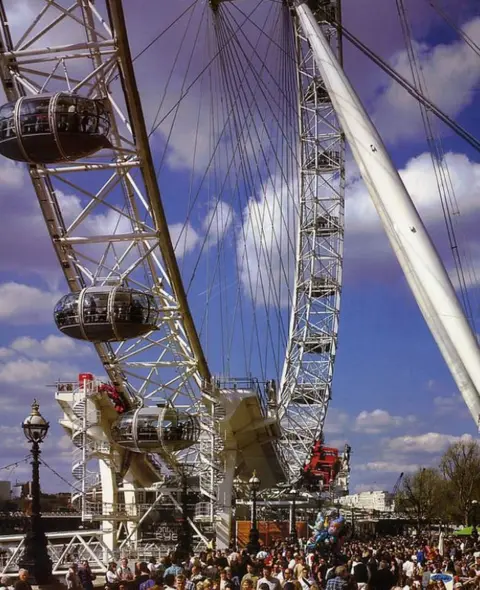 Marks Barfield Architects/Ian Lambot
Marks Barfield Architects/Ian Lambot
